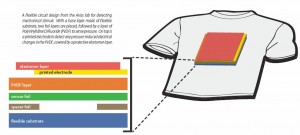Wearable electronics - the next fashion fad?
When most of us think of electronics, we think of the sturdy stability of silicon and plastic. Flexibility is a trait that belongs to the organic world, where materials come in all shapes and stiffness. However, advances in materials science and electrical engineering have paved the way for a new type of electronic device: one that can bend and fold just like a piece of paper. From flexible displays to disposable RFID tags, these new materials have enabled electronics to end up in places they never have before. They could even, thanks to Berkeley electrical engineering and computer science professor Ana Claudia Arias, end up in our own clothing.

Professor Arias is a recent addition to the Berkeley engineering community, having begun her career in materials science at the company Plastic Logic, developing materials called organic printed electronics. Just as one might print ink onto paper using a desktop printer, these electronics can be printed onto various flexible substrates, and Professor Arias’s goal is to create wearable electronics. As she explains, the benefit to being able to print a circuit onto any material is that “flexible electronics are thin, lightweight, and conformal, and can allow new form factors not currently available with established technologies.” Arias’s lab is looking into using printed electronics for flexible displays, wearable memory, and sensors the thickness of tape.
Organic electronics are interesting not only for their low power requirements, but also for their low-cost processing methods. Being able to print directly onto substrates in intricate patterns contrasts with the higher-cost methods used in traditional circuits whereby thin layers of material are deposited uniformly and then removed selectively to make patterns. By printing the pattern directly, engineers can skip the removal process. Layer-by-layer printing techniques like inkjet printing or gravure printing (e.g. newspaper printing presses) are natural tools for organic and polymeric solutions and can be performed sequentially on a variety of substrates.
Developing systems to print electronics requires overcoming a number of electrical and engineering problems. Every circuit begins with a transistor, or voltage-controlled switch, that allows one to control the amount of conduction between its two ends. These switches can be triggered by negative or positive voltages, but Arias’s group noticed that they were affected by stress from multiple cycles of voltage switching. By using circuitry that combines both positive voltage-enabled and negative voltage-enabled switches, a high input voltage can be turned into a low output voltage and vice versa. This allows the creation of complex circuits by canceling out shifts in the behavior of positive voltage-enabled and negative voltage-enabled devices, mitigating stress effects.
One use for these switches is in sensing devices, and Arias’s research has produced sensors that can detect ambient light (through photosensitive inks) and pressure. The basic structure of these sensors uses a slice of an organic polymer (PVDF) sandwiched between two electrodes. Exerting pressure on the polymer changes the polymer’s electrical characteristics, altering the voltage measured between the two electrodes. This design is modeled after similar sensors commonly used in car airbags, cell phones, and hard drives. Tailoring the thickness of the polymers and the materials used alters pressure sensitivity. One use for this type of sensor is as a blast dosimeter, a wearable device that detects shocks and stores data about them. Using existing technology for thin film batteries and a layer of circuitry including common electrical elements, a device as thin as a piece of tape becomes a functional, bendable pressure sensor.
With the ability to sense information, the next step was to find a way to store and display such information. Professor Arias’s group developed an organic, inkjet-printed method to create flexible small-area displays that make use of “e-inks”—positively and negatively charged particles suspended in a liquid. Depending on the voltage applied tothe device, either the negatively or positively charged particles will float upward. Because the differently charged particles are white and black, respectively, voltage controls the number of black or white particles at the surface, corresponding to the shade of black displayed for one pixel. A full black-andwhite image can be displayed on an array of these pixels, and by using the flexible substrate polyethylene naphthalate (PEN) as a base Professor Arias’s group created a flexible electrophoretic display.
While physical parts like displays and transistors can easily benefit from flexible materials, what about more intangible electrical properties like memory? Arias’s lab has created non-volatile memory produced with inkjet processing. In most computers, a constant trickle of electricity is needed to keep memory stable, but Arias’ organic material maintains previous states without power. This is accomplished using a transistor that relies on magnetism (not electricity) to store information. Although memory retention is only 8 hours, the technology could be used in applications that require continuous turnover.
Although we may be far from wearing electronics as a fashion fad, the applications of such technologies range from dynamic displays woven right into our shirts to embedded mechanical and ambient atmospheric sensors to obtain and store data about human movement and biological signals. These smart devices could change the way we use clothing. Professor Arias is already in the process of modifying her wearable electronics to fit a multitude of uses. Her previous work focused on defense applications, and she has branched into developing flexible magnetic resonance imaging (MRI) coils and wearable medical sensors. While there are still challenges involving performance, stability, and scalability, in Professor Arias’ words, “This is just the beginning; wearable sensors that measure environmental and biological signals can open up many applications for people who play sports, are in the hospital, or just want to monitor their daily health.” Flexible electronics can even be art; in collaboration with Professor Elad Alon and John Wawrzynek at the Berkeley Wireless Research Center, Professor Arias is also working on creating electronic wallpaper that will, she notes, cover walls with “electronics instead of flowers.”
